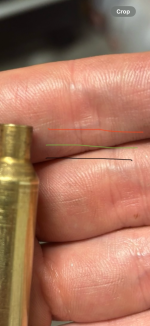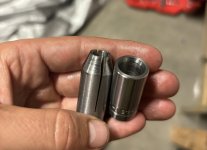I’m FL sizing with a Redding body die but struggling to get my Lee collet die to size the OD/ID consistently down the whole neck on this Lapaua 6.5cm brass
What I’m seeing is the red line gets sized to .289, green line to .290 and black line to .291/.292. I’ve seen this on every case, no matter if I run it through once or 10 times through the die. A normal FL die doesn’t do this, all lines will same about the same OD
I’ve tried screwing the die in more and more until I’ve run out of threads. I’ve also tried putting a lot of force on the handle of my single stage press and no luck. The mandrel OD measures all the same. When seating bullets I can feel normal force at first and then very little force because the neck OD is wider as the bullet is being seated
Any idea what’s going on?
What I’m seeing is the red line gets sized to .289, green line to .290 and black line to .291/.292. I’ve seen this on every case, no matter if I run it through once or 10 times through the die. A normal FL die doesn’t do this, all lines will same about the same OD
I’ve tried screwing the die in more and more until I’ve run out of threads. I’ve also tried putting a lot of force on the handle of my single stage press and no luck. The mandrel OD measures all the same. When seating bullets I can feel normal force at first and then very little force because the neck OD is wider as the bullet is being seated
Any idea what’s going on?



